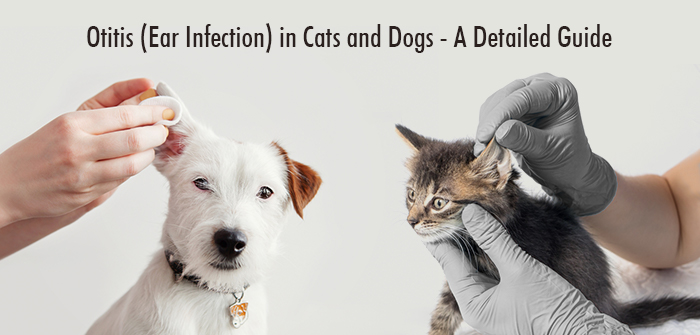Otitis (Ear Infection) in Cats and Dogs — A detailed guide
Otitis is a common term for ear infections. It is divided into different categories in dogs and cats (as well as humans and other species) based on the anatomic location of infection within the ear canal.
- Otitis external – Any infection that affects the external ear
- Otitis media – Any infection that affects the middle ear
- Otitis internal – Any infection that affects the inner ear

Causes of Otitis
Otitis occurs as a result of inflammation of the ear. The primary causes that are responsible for the inflammation include allergies, keratinisation disorders, polyps, cysts, tumours, ear mites, fleas, food reactions, endocrine diseases, etc.
Other factors that contribute to otitis externa can either predispose the ear to disease or prevent it from healing. Pendulous ears, restricted ear canals, dampness within the ears, secondary bacterial and yeast infections, and middle ear disease may also be the causes of otitis in pets.
Symptoms of Otitis
The symptoms of otitis are easy to spot. Some of the symptoms of Otitis externa include scratching near the ears, shaking the head, painful ears, red and inflamed ear pinna, discharge in the ear and malodour. Depending on which microorganisms have caused the infection, the discharge can be a thick brown waxy discharge or a purulent (pus) discharge.
Diagnostic Process
There are several steps involved in the diagnosis of otitis.
History
To help evaluate the underlying cause and associated circumstances, your vet may ask for a complete history of the problem.
Physical Examination
A thorough physical examination, which includes a thorough dermatologic examination, can aid in the identification of an underlying or primary cause. Your vet will examine your pet’s ears using an otoscope and may perform several tests that may give information about the amount of discharge, the changes in the ear canal, masses, foreign bodies and other things that may be causing the infection.
Sensitivity and Bacterial Culture
A swab sample taken from your pet’s ears is studied to determine the type of organisms (if any) that are present in the sample. Depending on this, your vet will guide the treatment.
Treatment
Treatment for otitis has five general goals:
- Get rid of unwanted discomfort and agony.
- Remove the debris and dispose of it.
- Get rid of the infection in both the external and middle ears.
- When feasible, reverse chronic pathologic alterations.
- Determine and treat the underlying cause of otitis.
Your veterinarian will use a therapeutic ear cleanser to thoroughly clean your dog’s ears. Your veterinarian may also recommend that you clean your dog’s ears with a good ear cleaner at home. Oral antibiotics and anti-inflammatory drugs may also be prescribed by your veterinarian in severe situations.
It is indeed vital to carefully follow your veterinarian’s recommendations and to return to the veterinary hospital for any recheck appointments that are needed. A recurrence of the infection is possible if your dog’s treatment is interrupted. Even if your dog appears to be improving, it is essential that you complete the entire course of treatment for your dog. Failure to complete the entire course of treatment may result in complications such as resistant infections.
Bottom Line
Ear infections are a frequent and often reoccurring condition in many dogs, but you can keep your dog’s ears clean and comfortable with the help of your veterinarian. If your dog is displaying symptoms of an ear infection, seek treatment as soon as possible to avoid the situation becoming more serious.

